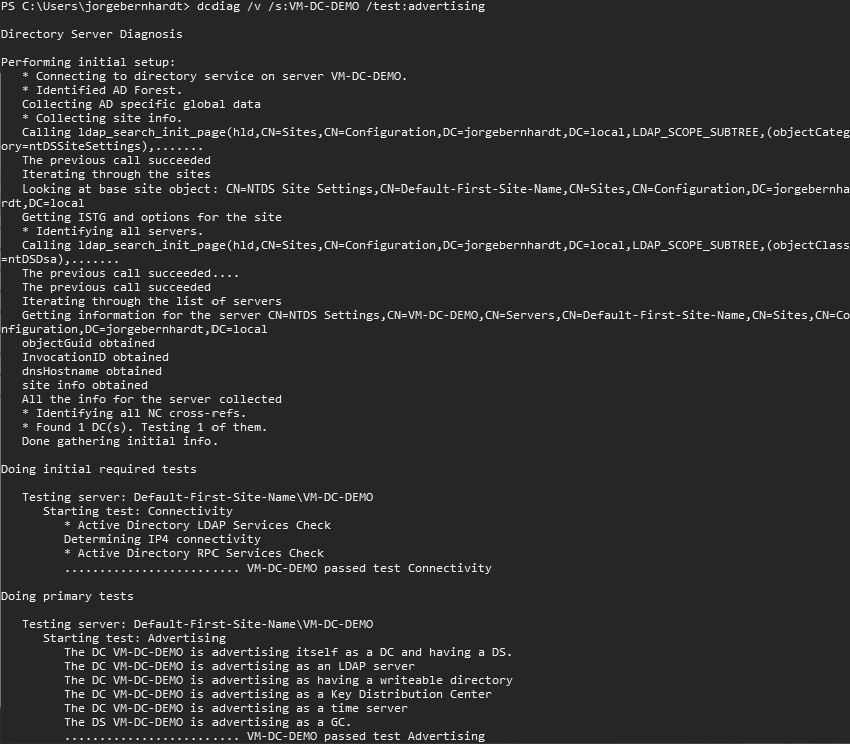How to Collect Information from Domain Controllers
Recently I have needed to collect information from domain controllers to generate a pre-migration report. To perform this task, I used different tools available on Windows Server. Today, in this post, I will show you how to collect information from domain controllers using a PowerShell script and command-line tools such as DCDIAG and NLTEST.
PowerShell Workaround #
Using the following script, we will obtain the requested information about all domain controllers that are online in our domain. Requirements:
- PowerShell version 3.0 or higher.
- PowerShell Active Directory module. To learn how to install this module, see this link.
# Import AD module
Import-Module ActiveDirectory
# Get your ad domain name
$DomainName = (Get-ADDomain).DNSRoot
# Get all Domain Controllers
$DCs = Get-ADDomainController `
-Filter * `
-Server $DomainName `
| Select-Object Hostname,isGlobalCatalog,IsReadOnly,Site,Forest,OperationMasterRoles
# Create empty DataTable object
$DCTable = New-Object System.Data.DataTable
$DCTable.Columns.Add() | Out-Null
$DCTable.Columns[0].Caption = "Hostname"
$DCTable.Columns[0].ColumnName = "Hostname"
$DCTable.Columns.Add() | Out-Null
$DCTable.Columns[1].Caption = "isGlobalCatalog"
$DCTable.Columns[1].ColumnName = "isGlobalCatalog"
$DCTable.Columns[1].DataType = "Boolean"
$DCTable.Columns.Add() | Out-Null
$DCTable.Columns[2].Caption = "IsReadOnly"
$DCTable.Columns[2].ColumnName = "IsReadOnly"
$DCTable.Columns[2].DataType = "Boolean"
$DCTable.Columns.Add() | Out-Null
$DCTable.Columns[3].Caption = "Site"
$DCTable.Columns[3].ColumnName = "Site"
$DCTable.Columns.Add() | Out-Null
$DCTable.Columns[4].Caption = "Forest"
$DCTable.Columns[4].ColumnName = "Forest"
$DCTable.Columns.Add() | Out-Null
$DCTable.Columns[5].Caption = "OperationMasterRoles"
$DCTable.Columns[5].ColumnName = "OperationMasterRoles"
$DCTable.Columns[5].DataType = "Microsoft.ActiveDirectory.Management.ADPropertyValueCollection"
ForEach($DC in $DCs)
{
$DCTable.Rows.Add( $DC.Hostname,
$DC.isGlobalCatalog,
$DC.IsReadOnly,
$DC.Site,
$DC.Forest,
$DC.OperationMasterRoles
)| Out-Null
}
# Display results in the console
$DCTable
The information collected is stored in a table and is shown at the end of the execution of the script as shown in the following screenshot.

DCDIAG #
The following command will display the list of services a domain controller is advertising.
dcdiag /v /s:<_DomainControllerName_> /test:advertising

NLTEST #
You can also use the nltest command-line tool. By running the following command on a domain controller, you will get the following result:
nltest /server:<_DomainControllerName_> /dsgetdc:<_DomainName_>
Flags #
The data received from the request contains a set of indicators that describe the domain controller. This can be zero or a combination of one or more of the following values.
-
DS_DNS_CONTROLLER_FLAG: The DomainControllerName member is in DNS format.
-
DS_DNS_DOMAIN_FLAG: The DomainName member is in DNS format.
-
DS_DNS_FOREST_FLAG: The DnsForestName member is in DNS format.
-
DS_CLOSEST_FLAG: The domain controller is on the same site as the client.
-
DS_DS_FLAG: The domain controller is a directory service server for the domain.
-
DS_FULL_SECRET_DOMAIN_6_FLAG: The domain controller is a Windows 2008 or later writable domain controller.
-
DS_GOOD_TIMESERV_FLAG: The domain controller is running a reliable Windows Time Service for the domain.
-
DS_GC_FLAG: The domain controller is a global catalog server for the forest specified by DnsForestName.
-
DS_KDC_FLAG: The domain controller is a Kerberos Key Distribution Center for the domain.
-
DS_LDAP_FLAG: The server is an LDAP server.
-
DS_NDNC_FLAG: The Domain Name is an application (non-domain) naming context.
-
DS_PDC_FLAG: The domain controller is the primary domain controller of the domain.
-
DS_SELECT_SECRET_DOMAIN_6_FLAG: The domain controller is a Windows 2008 or later read-only domain controller.
-
DS_TIMESERV_FLAG: The domain controller is running the Windows Time Service for the domain.
-
DS_WRITABLE_FLAG: The domain controller hosts a writable directory service (or SAM).
Thanks for reading until the end. I hope you find this article useful and share it.
If you want to know more about nltest command-line tool, check out this link.

